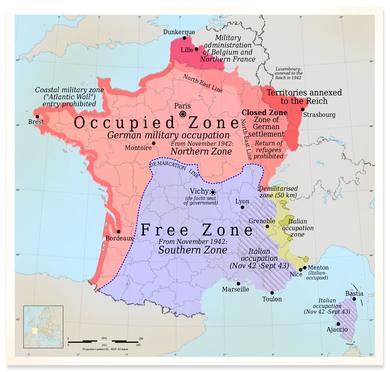During WWII and the defeat of France in 1940 the normally tranquil South of France took on a more febrile atmosphere. As the initially designated “Free Zone” as opposed to the “Occupied Zone” to the North, the Côte d’Azur became a haven for political and cultural refugees. Some hoping for visas to escape via Marseille to the United States or elsewhere. Others in hiding, or Jews seeking immunity in the Italian Zone to the South Eastern corner. Amidst the maelstrom various artist colonies formed, and through this exhibition we explore the stories of some of these artists in the context of wider historical events.
Christine Boumeester and Henri Goetz as non-French citizens found themselves “illegal aliens” in Paris, and escaped to Carcassonne in the South, where they found the Belgium Surrealists Ubac, Magritte and poet Scutenaire. The couple started making fake identity papers for people needing to escape, as well as contributing to the underground journal “La Main à la Plume”, until they were betrayed in 1942 and fled to Nice under false names.
Nice had already developed a congregation of artists, partly as it was in the Italian Zone where Jews were safe from deportation (until the Nazis took control in 1943). Hans and Sophie-Taeuber Arp (German and Swiss “aliens”) had escaped Paris just before it fell, and joined Alberto and Susi Magnelli in Grasse outside Nice. Sonia Delaunay also joined them after her husband’s death in 1941. The sculptor Francois Stahly who was a German national also took refuge there along with De Stael, Picabia, and Marie Raymond who had grown up in Nice with the sculptor Emile Gilioli. André Gide even set up a literary group hosting figures such as Sartre and de Beauvoir.
Meanwhile Marseille was a hotbed of clandestine activity as many people sought immigration papers to leave. The Emergency Rescue Committee largely funded by Eleanor Roosevelt helped rescue over 1000 people including artists André Breton, Marc Chagall, Tristan Tzara, André Masson, and Max Ernst after his escape from an internment camp. Although in the “Free Zone” it was still subject to strict Vichy rules and the fear of being betrayed by informants was ever present. Moise Kisling was denounced as a Jew and had to flee to Lisbon. Youla Chapoval being Jewish Ukrainian headed for Marseille from Paris in 1942 following the arrest of his mother and elder sister, but retreated to Toulouse with his remaining sister, and wrote “it is impossible to paint outside without fear of arrest”. Max Papart was born in Marseille and returned there to fight with the Resistance and eventually helped liberate the city in 1944.
This exhibition brings together a selection of these artists along with archive material highlighting the paradox of the extraordinary political and cultural turmoil on the French Riviera during this cataclysmic period, and its legacy.

